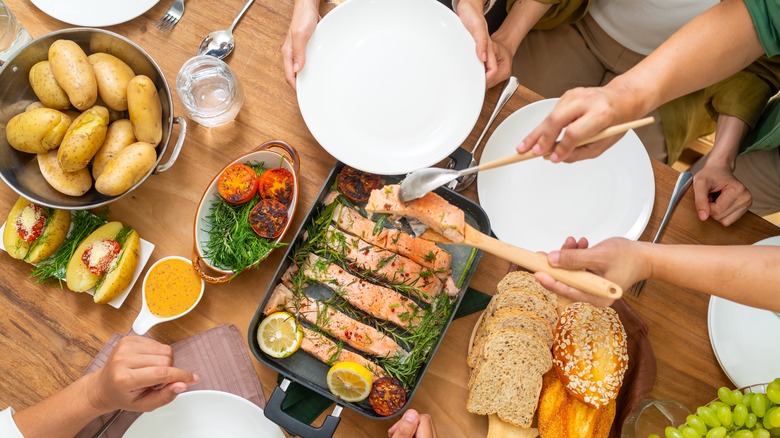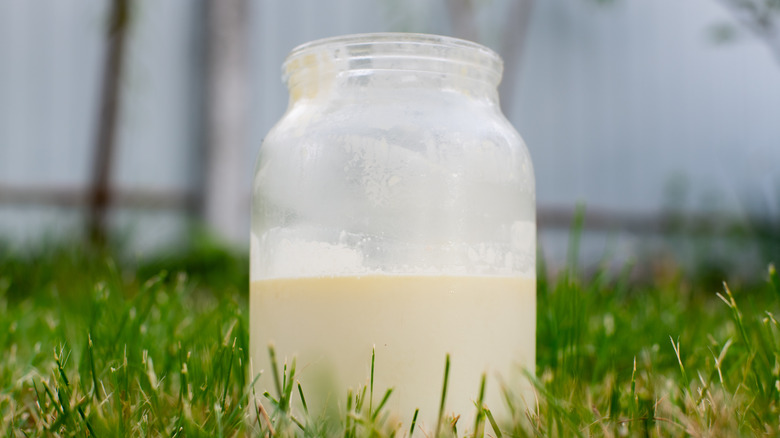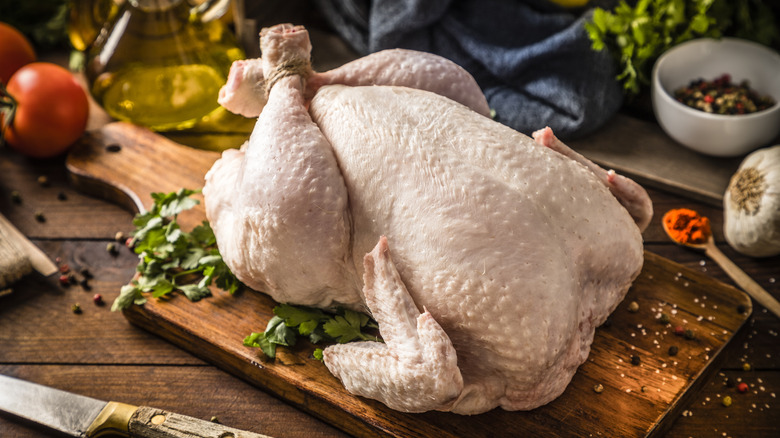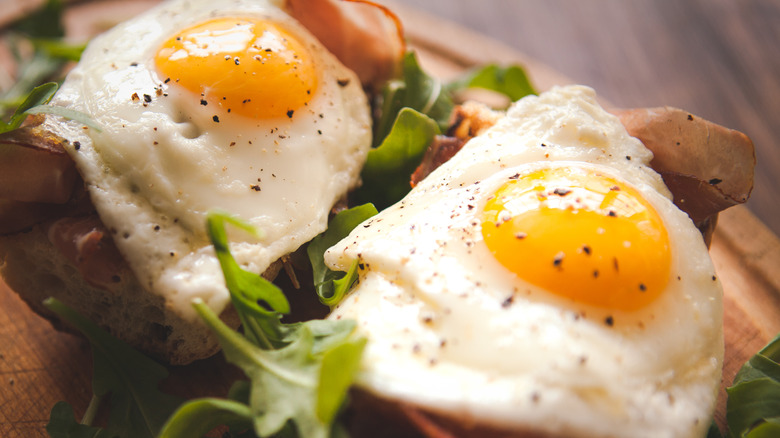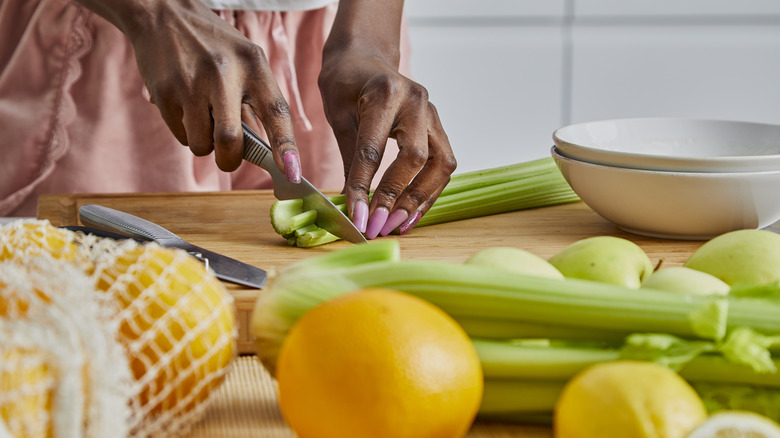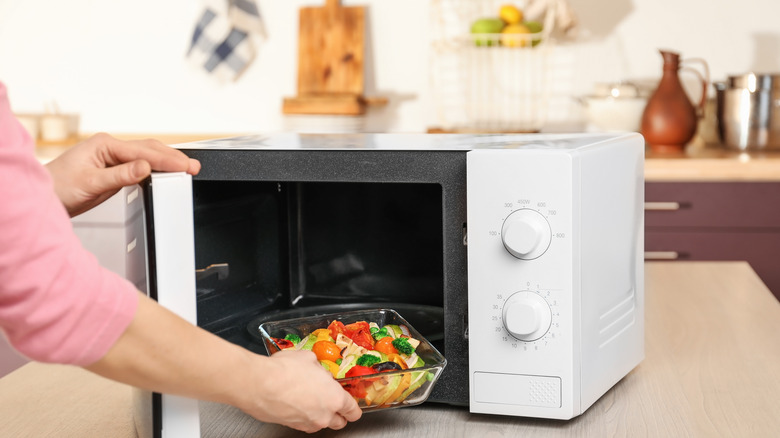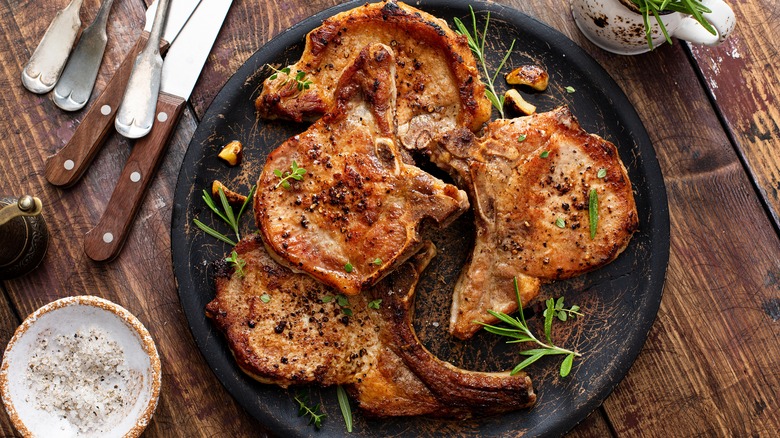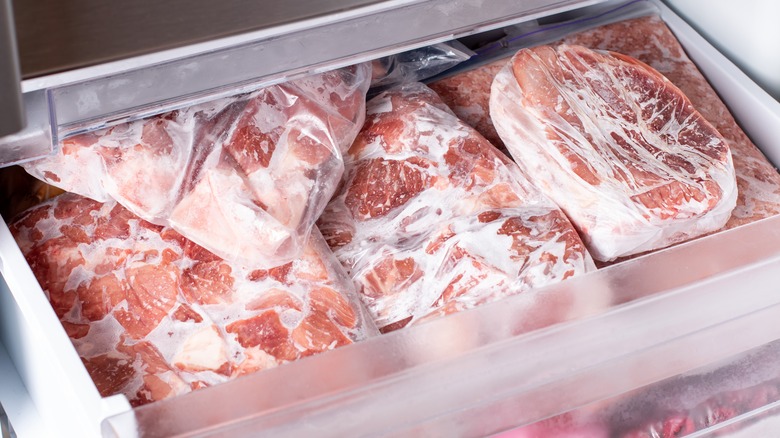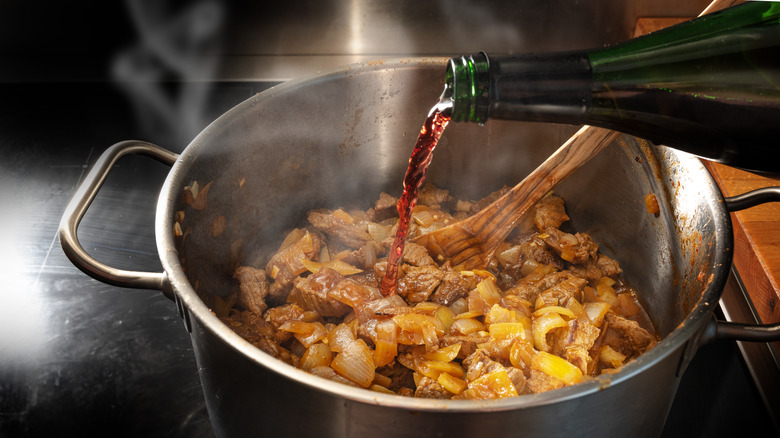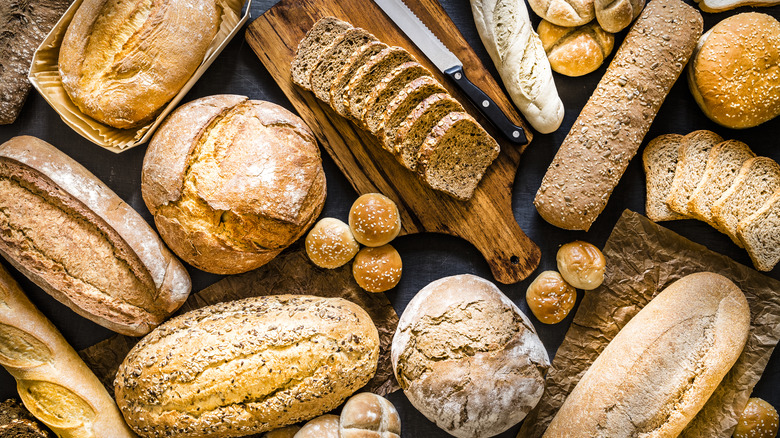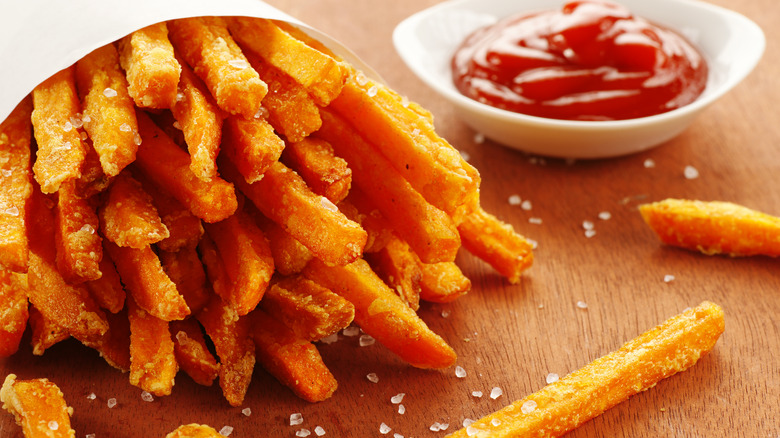False Facts People Believed About Food 50 Years Ago
Like any field, the culinary world constantly adapts based on new research and information. Many things that people used to believe were facts about food we've come to learn are false. The best way to prepare food, what foods are healthiest, and basic food safety protocols are all subject to change based on the most up-to-date scientific information.
Your parents and grandparents likely grew up with many different ideas about food, and you may be shocked at what people have believed for decades. Some of these ideas came from the science of the time, while others were popularized based on a poor understanding of nutrition. Regardless of its source, once a false fact is accepted, it can be hard to unlearn. If you've ever encountered someone defrosting meat the wrong way or making false claims about the health benefits of raw milk, they're likely basing that off food myths from the past.
By consulting new findings and expert opinions, we've compiled a list of some of the most pervasive false food facts that people believed years ago and some continue to believe. Keeping current on the correct food facts will lead to healthier, safer, and more enjoyable eating.
The health benefits of raw milk
Due to food regulations, you won't find raw milk at a typical grocery store. Instead, you'll find pasteurized milk, which has gone through the process of being heated to eliminate harmful bacteria. Although this process is commonplace, you may have heard of the supposed benefits of raw milk. Raw milk is simply milk that has not gone through this sterilization process.
For years, raw milk drinkers have claimed this is the healthier way to get your dairy. Advocates believe the non-pasteurized version contains more enzymes and beneficial bacteria. Mark McAfee, founder of Organic Pastures and distributor of raw milk, shared his thoughts with Bon Appétit. "Raw milk is like breast milk: non-allergenic, full of good bacteria, the ultimate immune-booster," he said. "Tens of thousands of people have reported to us that, when they drink raw milk, they have no problems digesting it, their children have a decreased risk of asthma, and their eczema is cured in four to six weeks."
These are bold claims on behalf of raw milk. However, the research doesn't seem to back them up, and the risks associated with drinking raw milk outweigh the potential benefits. The Centers for Disease Control and Prevention (CDC) warns that consuming raw milk may lead to foodborne illness, particularly for children, adults over 65, and anyone with a compromised immune system. Furthermore, studies have not found any significant nutritional loss between pasteurized and raw milk.
You need to wash poultry
Another food myth that may have been passed down to you is that you should wash poultry before cooking it. For years people rinsed raw chicken or turkey in a cold water bath to remove harmful bacteria from the chicken or turkey's surface. But, while you may have heard this advice from well-meaning home cooks, it's not good practice. In fact, washing raw poultry has the opposite of its intended effect and increases the risk of spreading bacteria.
A study by the United States Department of Agriculture (USDA) found that washing or rinsing raw poultry can spread bacteria from the meat to your kitchen sink and other kitchen surfaces, increasing the likelihood of the bacteria contaminating other foods. Instead of washing your poultry, there are a few easy steps you can take to reduce the risk of bacteria spread. Firstly, be careful to thoroughly wash surfaces, cutting boards, knives, and any other kitchen tools that come in contact with the raw meat. This is especially important when using those same tools on vegetables or other ingredients. Secondly, be sure to cook the poultry to a safe temperature. You can use a kitchen thermometer to check the internal temperature of your meat. Once poultry has reached 165 F, it's safe to eat. Harmful bacteria will be killed during cooking, eliminating any need to wash the meat.
Egg yolks were considered unhealthy
For far too long, egg yolks have been demonized for their high cholesterol content. This caused health enthusiasts to give up the flavorful yellow center for egg white omelets and other supposedly healthier alternatives. Bad press around egg yolks reached a peak in the 1980s. "When the cholesterol scare started in the '80s, eggs were an easy target," Linda Braun, consumer services manager for the American Egg Board, told the New York Times. "Americans like to think if they can remove just one thing from their diet, everything will be all right. Unfortunately, eggs were that one thing."
But just because food contains cholesterol doesn't mean you should never eat it. Whole eggs, including the delicious yolk, can make a healthy addition to your diet. The classic breakfast is a great way to start your day and not something to be scared of. While it's true that yolks contain most of an egg's cholesterol content, they also house vital nutrients such as iron, folate, and vitamins.
Furthermore, a recent study found that eating egg yolks in moderation won't increase your body's cholesterol levels in the way people feared during the '80s. Dr. Luc Djoussé, one of the researchers, told Time, "Current scientific data do not justify worries about egg consumption, including egg yolk, when it comes to heart health." Unless you have compounding health factors to consider, eating eggs in moderation is perfectly healthy, according to modern research.
Celery being a negative-calorie food
The concept of negative-calorie food stems from the idea that some foods, like celery, are so low in calories that you burn more calories by chewing the food than you gain from eating them. It sounds fairly logical and scientific. The idea that celery was one of these snacks gained enough popularity to cause many dieters to reach for the crunchy vegetable in the hopes of shaving off calories. But, while celery is indeed very low in calories and a good source of vitamins and dietary fiber, it's not actually a negative-calorie food.
According to nutritionist Sharon Richter, RD., it takes an hour of chewing to burn just 11 calories, and that's far longer than you'll spend chewing on a stalk of celery. Richter went on to advise that eating only low-calorie veggies such as celery or cucumbers is not a good option for healthy living. Calories give your body the energy it needs, so trying to live off of supposedly "negative-calorie" foods is not sustainable for anyone. "They should be part of a well-rounded diet with plenty of other kinds of fruits and vegetables to ensure you're getting a range of vitamins, minerals, and other nutrients your body needs," Richter advised (via GoodRx Health).
Losing nutrients in the microwave
Microwaves are an excellent time-saving option that uses electromagnetic waves to cook vegetables and other foods in a fraction of the time it would take to heat the same dish in the oven or stovetop. As microwaves became more popular, many were understandably suspicious of the miraculous technology, and the belief that microwaves zapped nutrients out of food gained wide acceptance. This is a food myth that your parents or grandparents likely believed and may have even taught you, but it's not actually true.
According to research done by Harvard Medical School, cooking food in the microwave may be one of the best ways to maintain nutrients. Some of the nutritional content of your food decreases when exposed to heat. Because of this, a cooking method like microwaving, which works quickly, gives the nutrients less time to break down and maintains a lot of the health content.
There are, of course, drawbacks to cooking in the microwave. We've all experienced a disappointing frozen dinner where you pop it in the microwave for the instructed time only to have pockets that are still cold while others are molten hot. And, of course, microwaving doesn't always give the best texture or flavor results. Nonetheless, it's a convenient heating method that works great for many foods, and you don't have to worry about it zapping out your nutrients.
Needing to overcook pork
If you've ever had a pork roast at your grandparent's house, you may not have had the most pleasant meal. Pork is often the victim of overcooking until it's dried out and tough to chew. But don't blame the cook for burning the meat. This is likely due to out-of-date information about how long you need to cook pork. In the past, the USDA recommended cooking pork until the internal temperature reached 160 degrees. This cooking temperature was recommended for years in order to prevent trichinosis, a foodborne illness often found in pork and other types of meat.
However, due to more recent advances and research, pork is now considered safe to eat once the internal temperature reaches 145 degrees. The USDA now recommends that whole cuts of pork be cooked to 145 F and allowed to rest for 3 minutes before slicing. These new guidelines result in juicier and flavorful meat while still cooking at a safe temperature. Keep in mind that ground pork and other kinds of meat should still be cooked to 160 F to avoid harmful bacteria.
This guideline change should have meat lovers rejoicing, as you can now have the best taste and texture for your favorite pork recipes while following safety protocol. But, although the USDA made this change back in 2011, many cooks still base cooking times off of the old requirements, resulting in overdone pork recipes.
It's safe to leave raw meat out
Imagine you're getting ready to prepare dinner, and you have frozen chicken breast in the freezer. If you want to defrost the meat quickly, you may think you can just leave it out on the counter to speed up the process. For years, many home chefs have done just this, believing it's safe to leave meat out at room temperature to defrost. But this is one kitchen myth that can have bad consequences. Leaving meat on the counter can lead to rapid bacteria growth and cause foodborne illness. To avoid this, you shouldn't leave perishable foods like raw meat at room temperature for longer than two hours.
There are a few options that you can use to safely thaw your meat. The first is to transfer the frozen meat from your freezer to your fridge and let it gently thaw at a cool temperature. You'll need to plan ahead for this method as it may take a full 24 hours for your meat to defrost in the low fridge temperature. For a faster option, the USDA recommends thawing meat in cold water. You can do this by sealing the meat in a plastic bag (be sure there are no leaks) and placing the bag in a large bowl of cold water. Change the water every 30 minutes until the meat thaws. You also should NOT thaw the meat in hot water.
Alcohol completely cooks out
Alcohol, particularly wine, is a common cooking ingredient used in sauces and marinades. You've likely prepared delicious dishes calling for a splash of red or white wine added to the sauce. The acidity in wine helps highlight other flavors and can help break down and tenderize meat for a juicy and flavorful dinner. Alcohol can also make a rich addition to baked goods like bourbon pecan pie or rum cake. But while the results are undoubtedly tasty, is boozy food really safe to share with the whole family?
Many believe that the alcohol completely evaporates during cooking, leaving nothing but its flavorful effects, but this is not entirely true. Although heat will reduce the alcohol content, it takes prolonged cooking to remove any trace of alcohol from a dish. There are many factors that affect how much alcohol remains in your food after the cooking time. The type of alcohol, cooking method, the size of the pan, and cooking time will all determine how boozy your recipe turns out. Findings have shown up to 40% of alcohol remaining after cooking for 15 minutes and that even after an hour, 25% of the alcohol content may still be present. While you can still cook with alcohol for flavor benefits, it's good to be aware and use an alternative ingredient if you're cooking for children, sober individuals, pregnant women, or anyone else who may not want to consume alcohol in their meals.
Carbs are bad for you
Because of diet trends, the word carbs has become synonymous with high-calorie, filling dishes like bread and pasta. This misconception has led to the demonization of carbs as something to be avoided, but carbohydrates can not only be a part of a healthy diet; they're essential to it.
To fully understand how incorrect this food myth is, you first need to know what carbs actually are. While you'll find carbohydrates in fluffy white bread and other baked goods, they're also present in all kinds of foods, including fruits, starches, and legumes. Carbohydrates are a basic food group that gives your body glucose, which is then converted into energy. It's an essential function for your physical activity every day.
Despite what you may have learned, cutting back carbs is not the secret to health. In fact, the more physically active you are, the more energy your body will need from carbs. For the healthiest carb options, you can opt for unprocessed carbs, such as whole grains, but don't try to remove them from your diet. Because of the variety of healthy foods containing carbs and the necessary function that carbohydrates serve, cutting them out is unrealistic and will have damaging side effects. Doing away with carbs can lower your energy and lead to nutrient deficiencies.
Low-fat foods are the healthier option
This is another false food fact that dieting trends have pushed forward for decades. Although many select the low-fat or diet versions of drinks and snacks in an attempt to be healthy, it often doesn't have the desired effect. It's true that an overly fatty diet, particularly one consisting of a lot of saturated fat, is unhealthy. However, dietary fat can be good for you.
Just like carbohydrates, fats play a role in your body's basic functions. Fats provide energy, aid in cell function, and allow your body to fully absorb nutrients. So, you shouldn't try to remove all fat from your diet. Instead, enjoy a variety of foods, and do your best to eat healthy fats in moderation.
Selecting fat-free or low-fat versions of your favorite snacks may sound like a smart way to lose weight or have a healthier lifestyle, but the opposite can be true. Abbey Sharp, RD, warns that low-fat foods aren't as filling. Because of this, you may end up hungry and craving more food soon after eating them. Plus, fat-free foods often have unhealthy additives. "These alternatives are often higher in sodium and sugar to make up for the lack of mouthfeel [from removing the fat], so they're not necessarily healthier," Sharp explained to Everyday Health.
Sweet potatoes are healthier than white potatoes
Although many diet plans and health coaches have touted sweet potato fries and baked sweet potatoes as the healthy alternative to classic potato recipes, it's not that clear cut. While it's true that sweet potatoes are a delicious and healthy ingredient that you can incorporate into many sweet potato recipes for a well-balanced diet, they aren't as different from white potatoes as you might think. Despite what you may have been taught, you can enjoy both white and sweet potatoes and get different health benefits from each one.
If you've always been told that sweet potatoes are the healthy choice, you may be shocked to see just how similar sweet potatoes and white potatoes are nutritionally. When it comes to calories, fat, carbs, and protein, the two types of potatoes are practically identical. Sweet potatoes have a much higher vitamin A concentration and more dietary fiber. However, regular white potatoes are a better source of potassium. So, which one is the "healthy choice" depends more on what is missing from your diet, and there's no need to reject white potatoes altogether.
